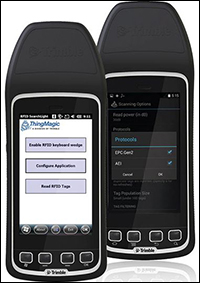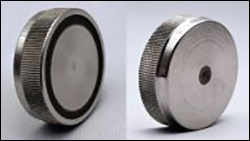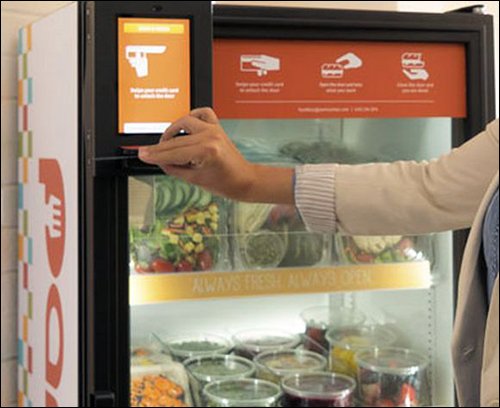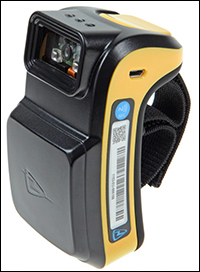The following are news announcements made during the past week by the following organizations:
Trimble;
InfoChip, Xerafy;
Pantry, Keonn Technologies;
ams, and Technology Solutions UK Ltd..
Trimble Intros Handheld UHF Reader for Tracking Railcars, Cargo
Trimble has introduced a rugged, handheld computer with an integrated ultrahigh-frequency (UHF) RFID capability designed to read both rail-industry-specific Automatic Equipment Identification (AEI) passive RFID tags and EPC Gen 2 RFID tags. The Trimble Juno T41 R-AEI works for tracking railcars fitted with AEI tags, as well as for cargo such as exposed shipping pallets that have EPC Gen 2 tags, the company reports. Mobile workers can record, view and act on data in their hands in real time, instead of waiting for instructions from a back office that has received data remotely from a traditional fixed-location reader dependent on rail cars passing by it, according to Trimble.
The Juno T41 R-AEI is a lightweight, rugged device that can interrogate tags in any direction or orientation in which the reader is pointed. Mobile workers can stand as far away as 8 feet (2.4 meters) to read an AEI tag and more than 12 feet (3.5 meters) to read EPC tags. It includes GSM/CDMA, Wi-Fi and Bluetooth technology and offers a customized power transmission up to +30 dBm (1 watt) for RFID collection and reading applications. The Juno T41 R-AEI includes Enhanced GPS technology for accuracy of 3 to 6 feet (1 to 2 meters) for use with the UHF RFID solution.
According to Trimble, the Juno T41 R-AEI is not only a rail RFID reader, but also a handheld computer designed to provide the field-computing power necessary to manage a wide variety of work requirements. It is available with either a Microsoft Windows or Android operating system, has a large, 4.3-inch sunlight-readable, a Corning Gorilla Glass capacitive display screen and 32 GB of flash memory. Mobile workers can use the handheld to fill out forms, read and write documents and instructions, make notes, take pictures or videos, and upload them in real time, the company reports. What’s more, users can share and retrieve data seamlessly from anywhere in the rail yard with wireless connectivity.
The handheld has an IP68 rating to meet the rail industry’s stringent requirements for dust and water protection, and also meets military-grade standards of ruggedness for drops, temperature, altitude, humidity extremes, vibration, chemical exposure and shock. In addition, the Juno T41 R-AEI can operate in environments ranging from –30 degrees Celsius (-22 degrees Fahrenheit) to 60 degrees Celsius (140 degrees Fahrenheit), the company reports. Trimble provides a software development kit (SDK) and application programming interfaces (APIs) to assist with integration of the handheld computer into company software applications. Secure business applications can run on the Juno T41 R-AEI, the company explains, while the Android version can run third-party applications designed for Android 4+ level products.
The Juno T41 R-AEI is available now from Trimble’s Mobile Computing Solutions division and selected rail-specialist dealers.
Xplorer Tag From InfoChip and Xerafy Approved for Drill Pipes
InfoChip and Xerafy have announced that an independent study of the Xplorer tag—a rugged ultrahigh-frequency (UHF) RFID tag designed to be embedded in drill pipe and survive extreme downhole conditions—shows no detrimental impact to asset integrity when embedded in a drill pipe.
The Xplorer, an ATEX-certified RFID tag encased in stainless steel, was developed in cooperation with oil and gas companies to provide drillers with an easy and accurate method of electronically identifying drilling pipe at distances as great as 5 feet, as it trips in and out of the well, the two companies explain. The tag is designed to reduce human error, ensure that the correct pipe is being deployed, collect and record data for advanced analytics, automate pipe tally, guide electronic field inspections, and perform many other tasks related to oilfield operations. Using the tag and fixed or handheld readers, the companies report, can help operators predict failure, increase the life of the pipe and reduce overall drilling cost.
InfoChip, which is the exclusive distributor of the Xplorer tag, announced that a finite element analysis (FEA) of the tag concludes that there is no detrimental impact to asset integrity when the tag is embedded in the tool joint of a drill pipe. T.H. Hill, the company that conducted the study, determined that “the pins of the connections had a lesser fatigue life than the RFID tag holes,” according to InfoChip.
Pantry’s RFID-enabled Food Kiosks Use Keonn UHF Antennas
Keonn Technologies has announced that Pantry, a U.S. fresh foodservice provider, is using 500 of Keonn’s Advantenna-p13 reader antennas to track inventory and sales of food from its kiosks. In July 2014, the company began selling its smart sensor-based refrigerated kiosk, known as a Pantry, which features a built-in RFID reader to track the items stored inside the unit via tags affixed to food packaging (see PantryLabs’ Vending Machine Dispenses Fresh Foods Via RFID). Pantry kiosks are now deployed across the country in workplaces, hospitals, universities and hotels to dispense fresh food and provide people with access to better food choices.
Customers can use Pantry’s kiosks by simply swiping a card in the card reader. Keonn’s antennas, incorporated inside the kiosks, track which items have been removed so that each item’s cost can be calculated and the customer can be properly charged.
Keonn’s Advantenna-p13 is a compact ultrahigh-frequency (UHF) RFID antenna with circular polarization and a radiation pattern characterized by a 40-degree beam width in the endfire direction and a 90-degree beam width in the broadside direction. According to Keonn, this radiation pattern makes this antenna suitable for many RFID applications, such as loss-prevention systems, portals, tunnels, corridors and doors.
The antenna offers a 6.8 dBi gain and operates in the 865 to 868 MHz and 902 to 928 MHz bands, with an operating detection distance of up to 4 meters (13.1 feet). It weighs 350 grams (12.3 ounces) and measures 417 millimeters by 137 millimeters by 3.3 millimeters (16.4 inches by 5.4 inches by 0.1 inch), excluding the connector.
Ams’ AS3993 IC Powers TSL’s 1153 Bluetooth Wearable UHF RFID Reader
Ams AG, a provider of sensors and analog ICs, has announced that the 1153, a rugged, wearable RFID scanner made by U.K.-based Technology Solutions UK Ltd. (TSL), is using its low-power AS3993 reader IC.
The 1153 Bluetooth Wearable UHF RFID Reader, which TSL released last year (see RFID News Roundup: Technology Solutions Intros Wearable, Bluetooth-enabled RFID Reader), is designed to be worn on a user’s hand so he or she can remain mobile. The device, which measures 10.2 centimeters by 5.5 centimeters by 5.6 centimeters (4 inches by 2.2 inches by 2.2 inches) and weighs 157 grams (5.5 ounces), comes with a palm strap so it can easily be worn on the back of the user’s hand. It also has an anchor point for attachment to a tablet computer. The reader supports the EPC Gen 2 and ISO 8000-6C RFID standards, the company reports, and can communicate via Bluetooth wireless technology with a variety of host devices, including enterprise handhelds, consumer phones, touchscreen MP3 players, tablets and PCs.
According to ams, the development team of the 1153 faced design challenges regarding performance, size and power consumption, and ams’ AS3993 was an ideal choice. First unveiled in 2012 (see RFID News Roundup: Austriamicrosystems Unveils New Reader Chips for Embedded and Consumer Applications), the IC is housed in a compact 7-millimeter by 7-millimeter (0.3-inch by 0.3-inch) QFN48 package, operates from a supply voltage as low as 2.7 volts, and is compatible with the 1,130mAh lithium-polymer battery in the 1153 reader. In normal mode, the AS3993 draws an operating current of 65mA.
The designers at TSL also benefited from the high level of integration in the AS3993, according to ams, as they worked to accommodate a complete RFID reader in a wearable form factor. Combining an RF front end with RFID protocol-handling circuitry, the AS3993 implements a complete EPC Gen 2 RFID system with only the addition of a simple external 8-bit microcontroller.
In the 1153, the AS3993 reads from and writes to ISO 18000-6C UHF transponders. The chip also includes support for ISO18000-6A/B in transparent mode, ams says. Featuring selectable receive sensitivity of up to -90dBm, and integrating a power amplifier with a transmit (output) power of 20dBm, the AS3993 gives the 1153 a very large link budget for robust performance, the firm reports, even in challenging operating conditions. The 1153 is specified with a nominal read range of up to 2 meters (6.6 feet) and a write range of up to 1 meter (3.3 feet), ams adds.
“We chose the AS3993 because it provided the best possible combination of reader performance with low power consumption for an ultra-compact, wearable UHF RFID reader,” said David Evans, TSL’s managing director, in a prepared statement. “Our requirement for efficient read performance with very low power consumption made it obvious that we should choose the ams AS3993.”
The 1153 RFID reader is available in versions for Europe, North America and Australia, and comes with or without a 2D bar-code imager. The AS3993 is available in production volume, with unit pricing at $35 in order quantities of 1,000.





